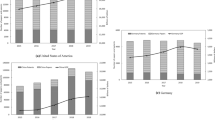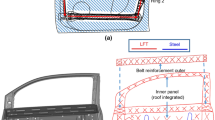Abstract
Modern software programs are routinely used by industries to study the characteristics of and to reduce the cost of sheet metal parts that are used in automotive and other applications. Virtual simulations that are based on complex math models and state-of-the-art computational tools play a very important role in reducing the high costs associated with prototypes and the time to market the product. Formability studies of a sheet metal part determine if a part is formable by changing the factors that affect its formability. Vibration (or modal) analysis is performed to determine the frequency and mode shapes of the component or the assemblies. A gauge optimization study is performed to determine the optimum gage thickness assigned to components of an assembly while constraining the frequency of specified modes to a desired level. Usually these studies are done separately by different engineering departments in a typical automotive industry. In this paper, a single component from an instrument panel (IP) reinforcement assembly is analyzed by integrating the three different studies mentioned above. It was found that the thickness of the bracket and the coefficient of friction in the stamping process should be kept as low as possible to reduce the chance of splits occurring in the bracket. An optimum thickness for the same bracket as part of an assembly can also be determined using a gauge optimization study so that the assembly was stiff enough while minimizing its mass. Thus, an integrated analysis using simulation tools helps in better design of the parts and subassemblies, which ultimately helps stay in competition to produce quality products.











Similar content being viewed by others
Abbreviations
- DOE:
-
Design of experiments
- RSM:
-
Response surface methodology
- CAD/CAE:
-
Computer aided design/engineering
- FEA/M:
-
Finite element analysis/modelling
- IP:
-
Instrument panel
References
Taguchi G (1987) System of experimental design. Quality Resources 1 and 2, American Supplier Institute, New York
Montgomery, Douglas C (2005) Design and analysis of experiments, 6th edn., Wiley, Hoboken
Wagoner RH, Chenot JL (2005) Metal forming analysis. Cambridge University Press, UK
Kobayashi S, Altan T (2005) Metal forming and the finite-element method. Oxford University Press, New York
Hasford, William F, Caddell, Robert M (2007) Metal forming—mechanics and metallurgy, 3rd edn., Cambridge University Press, Cambridge
Banabic D (2009) Sheet metal forming processes: constitutive modelling and numerical simulation, 1st edn., Springer, Heidelberg. ISBN: 978-3-540-88112-4
Stander N (2001) The successive response surface method applied to sheet-metal forming. In: Proceedings, first MIT conference on computational fluid and solid mechanics, pp 481–485, June 12–15
Jakumeit J, Herdy M, Nitsche M (2005) Parameter optimization of the sheet metal forming process using an iterative parallel Kriging algorithm, vol 29, N 6, Springer, Berlin, pp 498–507. ISSN 1615-147X
Naceur H, Ben Elechi S, Batoz JL (2005) On the design of sheet metal forming parameters for springback compensation. In: VIII International Conference on Computational Plasticity (COMPLAS VIII), Barcelona
Zhang W (2007) Design for uncertainties of sheet metal forming process, Doctoral Dissertation, The Ohio State University, Columbus
Tang Y, Chen J (2009) Robust design of sheet metal forming process based on adaptive importance sampling, vol 39, N 5, Journal Structural and Multidisciplinary Optimization Publisher Springer, Berlin, pp 531–544. ISSN 1615-147X (Print)
Shivpuri R, Zhang W (2009) Robust design of spatially distributed friction for reduced wrinkling and thinning failure in sheet drawing. Mater Des 30(6):2043–2055
Marretta L, Ingaraoa G, Di Lorenzo R (2010) Design of sheet stamping operations to control Sprinback and thinning: a multi-objective Stochastic Optimization Approach. Int J Mech Sci 52(7):914–927
Echempati R, Sathya VMS (2002) Statistical design study of aluminum forming, In: Proceedings of NUMISHEET International Congress, S. Korea, vol 1, pp 665–670
Fox A, Echempati R (2009) Modelling, forming, modal analysis, and gauge optimization of sheet metal parts, In: Proceedings of the ASME 2009 international manufacturing science and engineering conference (MSEC2009), West Lafayette, Indiana, USA, 4–7, October, 2009
Echempati R, Fox A (2010) Integrated metal forming, vibration analysis, and thickness optimization of sheet metal parts, In: Proceedings of TMCE 2010 conference held in Ancona, Italy, p 731
HyperWorks User’s manual (2010), Altair engineering
DYNAFORM/LS-DYNA 971 User’s manual (2009)
Palm WJ III (2007) Mechanical vibration. Wiley, Hoboken
Feng W, Hallquist J (2003) On constitutive equations for elastomers and elastomeric foams, In: Proceedings of 4th European LS-DYNA users conference, D-II-15, Ulm, Germany, 22–23 May 2003
Author information
Authors and Affiliations
Corresponding author
Rights and permissions
About this article
Cite this article
Echempati, R., Fox, A. Integrated metal forming and vibration analysis of sheet metal parts. Engineering with Computers 29, 307–318 (2013). https://doi.org/10.1007/s00366-012-0273-y
Received:
Accepted:
Published:
Issue Date:
DOI: https://doi.org/10.1007/s00366-012-0273-y




